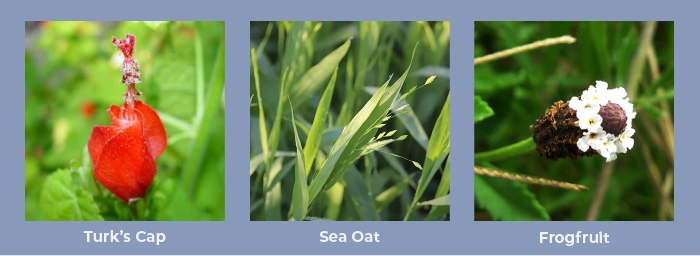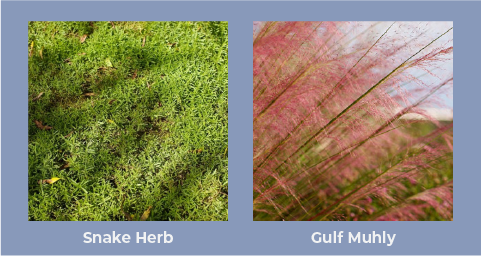Want to build a rain garden, but not sure where to start? Consider your landscape’s sun and shade situation before you pick your plants.
With all the rain we’ve been getting — and the possibility of more on the way — it may be a good idea to invest in a rain garden.
Rain gardens have many benefits and are good for the environment. Here’s a must watch video that demonstrates a real-life rain garden in action!
Now for the fun stuff — plants! I’ll walk you through two different designs: one for a rain garden located in shade or partial shade and another one for full sun. Remember the plants you place at the base of the rain garden must be tolerant of poor drainage.
Shade/Partial Shade Rain Garden
For a rain garden in shade, look to nature for inspiration. When you take a stroll near a perennial or ephemeral stream, what do you see growing in the shade? I see Turk’s cap, inland sea oats and frog fruit, among other things. These are some of the plants you want in your rain garden, plants that can handle periods of inundation as well as dry periods and, of course, shade. Turk’s cap, inland sea oats and frogfruit are all beneficial to wildlife — and they’re all included in the WaterSaver Landscape Coupon! They can be placed at the base, sides and/or top of the garden.

Sun Rain Garden
For a rain garden in the sun, seek out plants that thrive in sunny spots near streams or dry creek beds. If you’re using the landscape coupon (and why wouldn’t you?), the plants that come to mind are Lindheimer’s muhly grass, gulf muhly grass, snakeherb and frogfruit. Again, these can be placed at the top, sides and base of the rain garden.

Before heading to the nursery, put your design down on paper. Start by drawing the outline of your rain garden and place the larger specimens first. Be sure to take into account the mature height and width of the plant, all of this information can be found in the Find a Plant section. Then, follow with the smaller specimens for your rain garden. You may prefer the look of one of these plants planted en masse, or you may prefer diversity in the rain garden.
Whatever your preference, SAWS can help you offset the cost of the planting material with a Watersaver Landscape Coupon. Remember the area transformed from turf to a landscape bed must be at least 200 square feet. If your rain garden is not that large, consider planting the area around the rain garden to equal the minimum square footage required for coupon eligibility. Also, per coupon requirements there must be at least 15 plants in the new landscaped area.
Ready, set, plant a rain garden! You’ll not only improve the aesthetic of your property and water quality of local rivers and streams, but also provide refuge and nectar sources for pollinators and birds.


